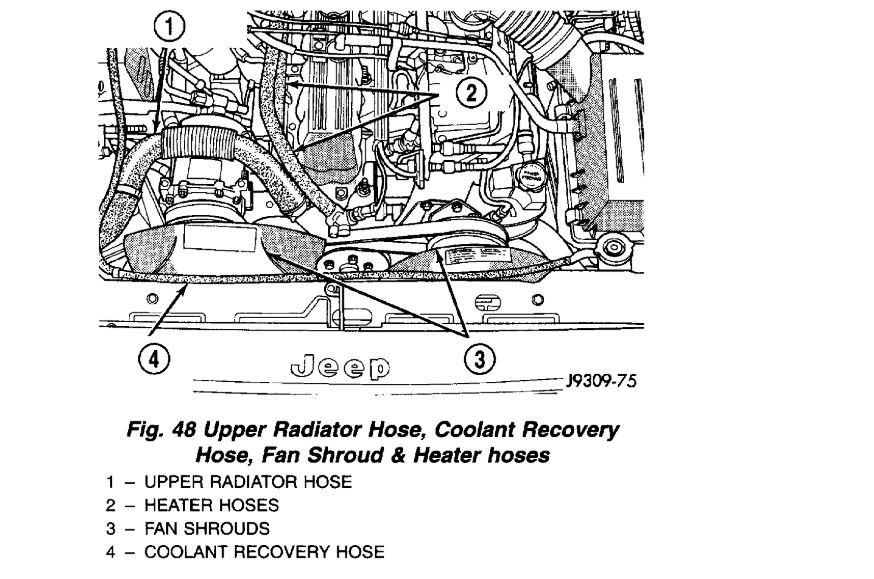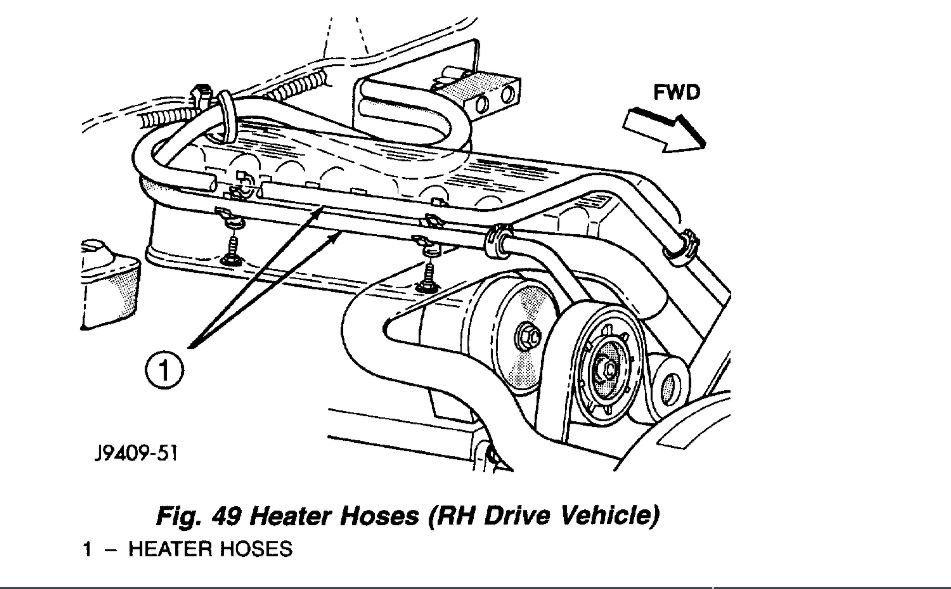I will attach the procedure below.
As far as the connectors, you will need to mark them yourself for installation.
Roy
REMOVAL
1. Disconnect the battery cables. Remove the battery,
2. Mark the hinge locations on the hood panel for alignment reference during installation. Remove the engine compartment lamp. Remove the hood.
Warning: the coolant in a recently operated engine is hot and pressurized. Use care to prevent scalding by hot coolant. Carefully release the pressure before removing the radiator drain cock and cap
3. Remove the air cleaner assembly.
4. Loosen the radiator drain cock and radiator cap to drain the coolant. DO NOT waste usable coolant. If the solution is clean, drain the coolant into a clean container for reuse.
5. Remove the lower radiator hose.
ImageOpen In New TabZoom/Print
Fig. 48
imageOpen In New TabZoom/Print
Fig. 49
6. Remove the upper radiator hose and coolant recovery hose (Fig. 48).
7. Remove upper radiator support retaining bolts and remove radiator support.
8. Remove the fan shroud and electric cooling fan.
9. Disconnect the transmission fluid cooler tubing (automatic transmission).
10. Disconnect radiator fan switch wire connector.
11. Vehicles with Air Conditioning:
a. Discharge A/C system (refer to Heating and Air Conditioning for proper procedures)
b. Disconnect the suction/discharge hose and cap off compressor ports to prevent foreign material and refrigerant oil loss.
12. Remove the radiator or radiator and condenser (if equipped with A/C).
13. Remove the fan assembly from the idler pulley.
14. Disconnect the heater hoses at the engine thermostat housing and water pump.
15. Disconnect the throttle cable.
16. Disconnect the speed control cable (if equipped).
17. Disconnect the line pressure cable (if equipped with automatic transmission).
18. Disconnect the fuel injector harness at the injectors.
19. Disconnect the distributor electrical connection and the oil pressure switch connector.
WARNING: THE FUEL SYSTEM IS UNDER A CONSTANT PRESSURE (EVEN WITH THE ENGINE TURNED OFF). BEFORE DISCONNECTING FUEL LINES, THE FUEL SYSTEM PRESSURE MUST BE RELEASED.
20. Perform the Fuel System Pressure Release procedure (refer to Powertrain Management).
21. Remove the latch clip and disconnect fuel supply line.
22. Remove the power brake vacuum check valve from the booster, if equipped.
23. If equipped with power steering:
a. Disconnect the hoses from the fittings at the steering gear.
B. Drain the pump reservoir.
C. Cap the fittings on the hoses and steering gear to prevent foreign objects from entering the system.
24. Identify, tag and disconnect all necessary wire connectors and vacuum hoses.
25. Raise and support the vehicle.
26. Disconnect the wires from the starter motor solenoid.
27. Remove the starter motor.
28. Disconnect the exhaust pipe from the manifold.
29. Disconnect the engine speed sensor wire connection.
30. Remove the exhaust pipe support.
31. Remove the flywheel and converter housing access cover.
32. Vehicles with Automatic Transmission:
a. Mark the converter and drive plate location.
B. Remove the converter-to-drive plate bolts.
33. Remove the upper flywheel and converter housing bolts and loosen the bottom bolts.
34. Remove the engine mount cushion-to-engine compartment bracket bolts.
35. Lower the vehicle.
36. Attach a lifting device to the engine.
37. Raise the engine off the front supports.
38. Place a support or floor jack under the converter (or flywheel) housing.
39. Remove the remaining converter (or flywheel) housing bolts.
40. Lift the engine out of the engine compartment.
INSTALLATION
CAUTION: When installing the engine into a vehicle equipped with an automatic transmission, be careful not to damage the trigger wheel on the flywheel.
1. Attach a lifting device to the engine and lower the engine into the engine compartment. For easier installation, it may be necessary to remove the engine mount cushions from the engine mount bracket as an aide in alignment of the engine to the transmission.
2. Vehicles with Manual Transmission:
a. Insert the transmission shaft into the clutch spline.
B. Align the flywheel housing with the engine.
C. Install and tighten the flywheel housing lower bolts finger tight.
3. Vehicles with Automatic Transmission:
a. Align the transmission torque converter housing with the engine.
B. Loosely install the converter housing lower bolts and install the next higher bolt and nut on each side.
C. Tighten all 4 bolts finger tight.
4. Install the engine mount cushions (if removed).
5. Lower the engine and engine mount cushions onto the engine compartment brackets. Install the bolts and finger tighten the nuts.
6. Remove the engine lifting device.
7. Raise and support the vehicle.
8. Install the remaining flywheel and converter housing bolts. Tighten all bolts to 38 Nm (28 ft. Lbs.) Torque.
9. Vehicles with Automatic Transmission:
a. Install the converter-to-drive plate bolts.
B. Ensure the installation reference marks are aligned.
10. Install the flywheel and converter housing access cover.
11. Install the exhaust pipe support and tighten the screw.
12. Tighten the engine mount-to-bracket bolts.
13. Connect the engine speed sensor wire connections and tighten the screws.
14. Connect the exhaust pipe to the manifold.
15. Install the starter motor and connect the cable.
16. Connect the wires to the starter motor solenoid.
17. Lower the vehicle.
18. Connect all the vacuum hoses and wire connectors identified during engine removal.
19. Vehicles with Power Steering:
a. Remove the protective caps
b. Connect the hoses to the fittings at the steering gear. Tighten the nut to 52 Nm (38 ft. Lbs.) Torque.
C. Fill the pump reservoir with fluid.
20. Install the power brake vacuum check valve to the booster, if equipped.
21. Connect the fuel supply hose the fuel rail. Push until a "click" is heard. Install latch clip
22. Connect the fuel injector harness to the injectors.
23. Connect the distributor electrical connector and oil pressure switch connector.
24. Connect the line pressure cable (if equipped with automatic transmission).
25. Connect the speed control cable, if equipped.
26. Connect the throttle cable.
27. Connect the heater hoses at the engine thermostat housing and water pump.
28. Install the fan assembly to the idler pulley.
29. Connect the suction/discharge hose to the compressor.
30. Connect automatic transmission fluid cooler lines, if equipped.
31. Install the fan shroud, electric cooling fan and radiator and condenser (if equipped with A/C).
32. Connect the electric fan connector.
33. Install upper radiator support.
34. Connect the upper radiator hose.
36. Connect the lower radiator hose.
36. Align the hood to the scribe marks. Install the hood.
37. Install the air cleaner assembly.
38. Install the battery and connect the battery cable.
39. Add the proper amount of engine oil and coolant.
WARNING: USE EXTREME CAUTION WHEN THE ENGINE IS OPERATING. DO NOT STAND IN A DIRECT LINE WITH THE FAN. DO NOT PUT YOUR HANDS NEAR THE PULLEYS, BELTS OR FAN. DO NOT WEAR LOOSE CLOTHING.
40. Start the engine, inspect for leaks and correct the fluid levels, as necessary.
41. Charge the air conditioning system (refer to Heating and Air Conditioning for proper procedures).
Images (Click to make bigger)
Sunday, October 14th, 2018 AT 5:23 PM





